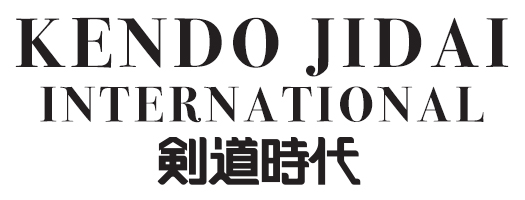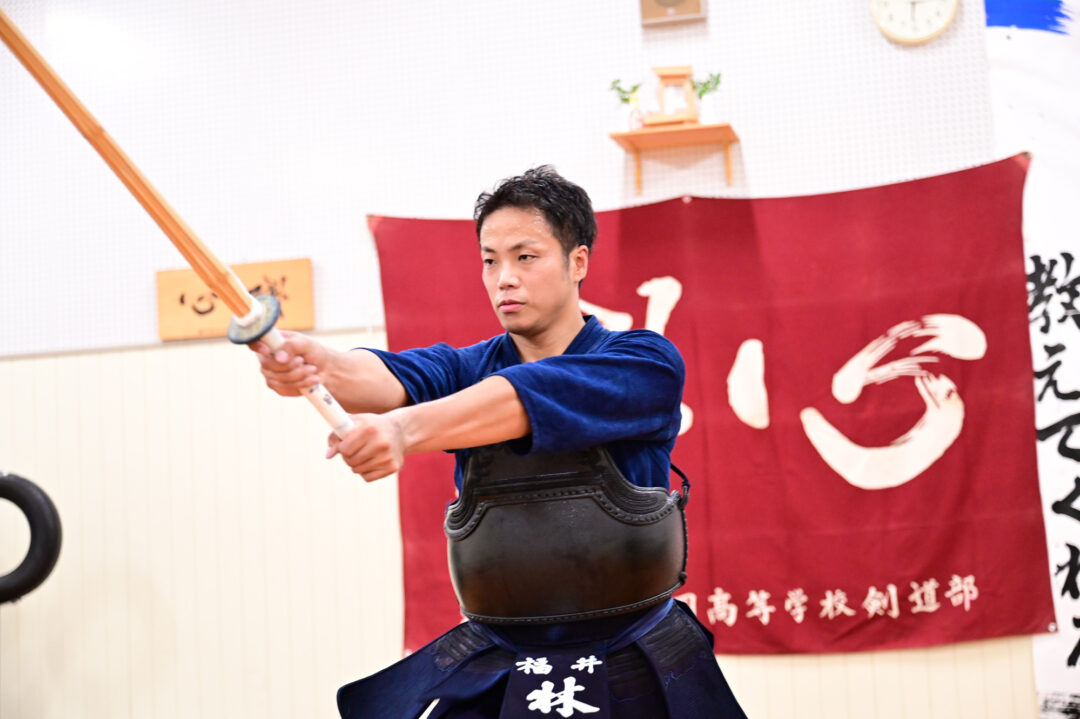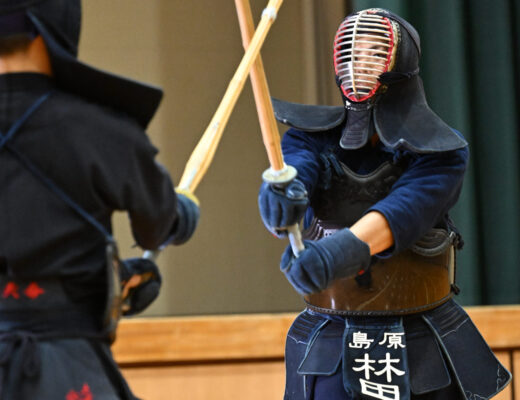2024.12 KENDOJIDAI
Composition by: Teraoka Tomoyuki
Photography by: Nishiguchi Kunihiko
Translation by: Sato Mariko, Pepijn Boomgaard
Runner-up in the All Japan Championship and a former member of the Japanese national team, Hayashida Kyohei is a standout among competing teachers. In recent years, he has focused his training on the theme of “relaxation,” captivating audiences with astonishing Men techniques in various tournaments. “By focusing on relaxation and utilizing my shoulders, I feel I’ve increased my chances of capturing Debana opportunities,” says Hayashida. Here, he shares insights on the key points of Debana, drawn from his own experiences.
Hayashida Kyohei
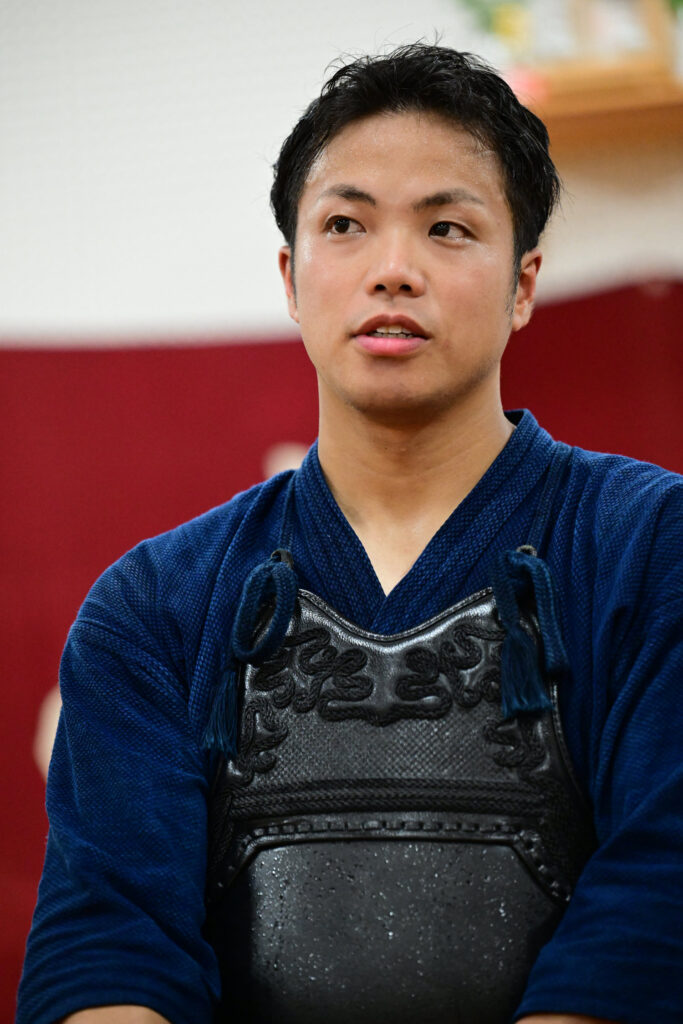
Born in 1994 in Nagasaki Prefecture, he attended Shimabara High School before advancing to Tsukuba University. After graduation, he began his career as a high school teacher in Fukui Prefecture. As a leading figure among teaching Kenshi, he has achieved notable successes, including a runner-up finish in the All Japan Kendo Championship and a victory in the National Teacher’s Tournament. Currently, he serves as a teacher at Maruoka High School, where he balances his roles as both an athlete and a coach while continuing to refine his Kendo skills.
Reevaluating Kendo During the COVID-19 Pandemic:
Focusing on Relaxation in Training
As a teacher at Fukui Prefectural Maruoka High School, I dedicate my time to guiding students while also training rigorously to achieve my goal of becoming the best in Japan as a Kendo competitor. The theme of “Debana” is inseparable from the style of Kendo I strive to embody, and I am still exploring and refining my approach. Since my Kendo practice is largely intuitive, I may find it challenging to articulate my thoughts clearly. However, I would like to share my insights into the significance and key points of Debana, based on my experiences as both a competitor and a coach.
I honed my Kendo skills at Shimabara High School and Tsukuba University, and my upbringing in Kyushu influenced a style deeply focused on competition. While I still aim to be the best in Japan and have not abandoned my competitive spirit, in recent years, I have dramatically transformed my approach to Kendo, particularly in tournaments. The turning point came during the COVID-19 pandemic.
In 2018, just before the pandemic, I had the privilege of being selected to represent Japan at the World Championships. However, I did not have the opportunity to actually compete. At that time, I was grappling with a sense of limitation in my Kendo and felt that I needed to make significant changes to progress further. When the pandemic struck, I saw the period of limited Kendo practice as an opportunity to reevaluate my entire approach — from my Kamae and the way I handled the Shinai to the timing of my strikes. It was during this process that I realized the importance of “relaxation” in Kendo.
One of the most significant changes I made was how I gripped the Shinai with my right hand. Previously, I firmly held the Shinai using my thumb and index finger, believing that this grip allowed me to adapt to my opponent’s movements and execute various techniques. However, upon reflecting on my Kendo, I realized that this approach prioritized “hitting effectively” rather than truly mastering powerful and effective strikes.
Participating in training camps with the national team gave me the opportunity to observe and learn from the grips of top-level players. After careful consideration and experimentation, I arrived at the conclusion that “it’s better not to grip the Shinai tightly.” This shift in perspective fundamentally transformed my Kendo.
Currently, I grip the Shinai with both hands just lightly enough to wrap around the handle, so much so that it would easily slip out if pulled. While this makes it harder to adjust my strikes to match my opponent, it has shifted my focus toward Men techniques. As a result, I’ve developed a completely different feel for executing Men strikes.
Additionally, the emphasis on relaxation has made it easier to defend against incoming strikes, eliminated unnecessary tension, and reduced fatigue during matches. The benefits of this approach far outweigh the drawbacks. By refining this style of Kendo, I was able to advance to the finals of the All Japan Championship. I recall that the majority of the techniques I successfully executed in the tournament were Men strikes.
Focus on Strikes That “Cut” Using Your Shoulders
Always Be Prepared to Strike at Any Moment
Focusing on Men techniques in Kendo naturally heightened my awareness of capturing Debana opportunities. It is often said that creating opportunities for Debana requires applying pressure (Seme), but I believe that achieving this begins with a solid Kamae. A well-prepared Kamae enables you to strike at any moment, which inherently creates a state of applied pressure.
When you adopt a relaxed Kamae, it becomes easier to perceive your opponent’s movements and intentions. This awareness is a crucial factor in identifying and seizing Debana opportunities.
In my striking movements, I focus on utilizing my shoulders. This is closely linked to relaxation, as gripping the Shinai too tightly tends to result in wrist-driven, superficial strikes. By loosening my grip, I naturally engage my shoulders, which allows me to execute sharp, clean Men strikes that feel more like “cutting” the opponent rather than merely hitting.
To execute a Debana strike, it is essential to influence your opponent’s mindset and draw them out. I focus on pressuring primarily the Omote and Ura sides with Men to apply Seme, but that alone rarely creates opportunities for Debana. At times, I intentionally retreat or use my right foot to feign an attacking motion, aiming to unsettle my opponent’s composure.
During these maneuvers, it is crucial to keep the left foot steady and maintain readiness to strike immediately when the opponent moves forward.
I believe that without mastering Men techniques, every Kendo practitioner will eventually hit a wall. This is why I emphasize Men techniques when teaching the students at Maruoka High School—it is a fundamental skill for sustaining a long-term Kendo practice.
Moreover, practicing Debana techniques is also crucial for progression in Dan examinations. For this reason, I encourage adults, in particular, to focus on executing Debana strikes in their daily training rather than being preoccupied with immediate victories. Debana is highly intuitive and cannot be fully developed through predetermined drills alone. Instead, engaging in Jigeiko and exchanging techniques with an opponent using the Shinai is the best way to cultivate this sensitivity.
Kamae
I believe that Kamae is a crucial element for executing Debana strikes. A well-prepared Kamae allows you to seize striking opportunities instantly without hesitation and naturally applies pressure during exchanges with your opponent.
In recent years, I have focused on the theme of relaxation in my training, with particular attention to my grip with the right hand. If the right hand grips the Shinai too tightly, the Shinai tends to stand upright during strikes, revealing your intentions to your opponent. Since Debana opportunities only last for an instant, such tension prevents you from capturing them effectively. By relaxing my right hand, I can now deliver straight and clean Men strikes without unnecessary movements. Additionally, my strikes have become sharper and more decisive, increasing their effectiveness.
Regarding my lower body, I focus on placing my weight on the ball of my left foot and engaging my left hip. To transition instantly into a strike, the left foot must always be ready. For this reason, when facing my opponent in Kamae, I aim to keep moving, maintaining a position that allows me to strike at any moment.
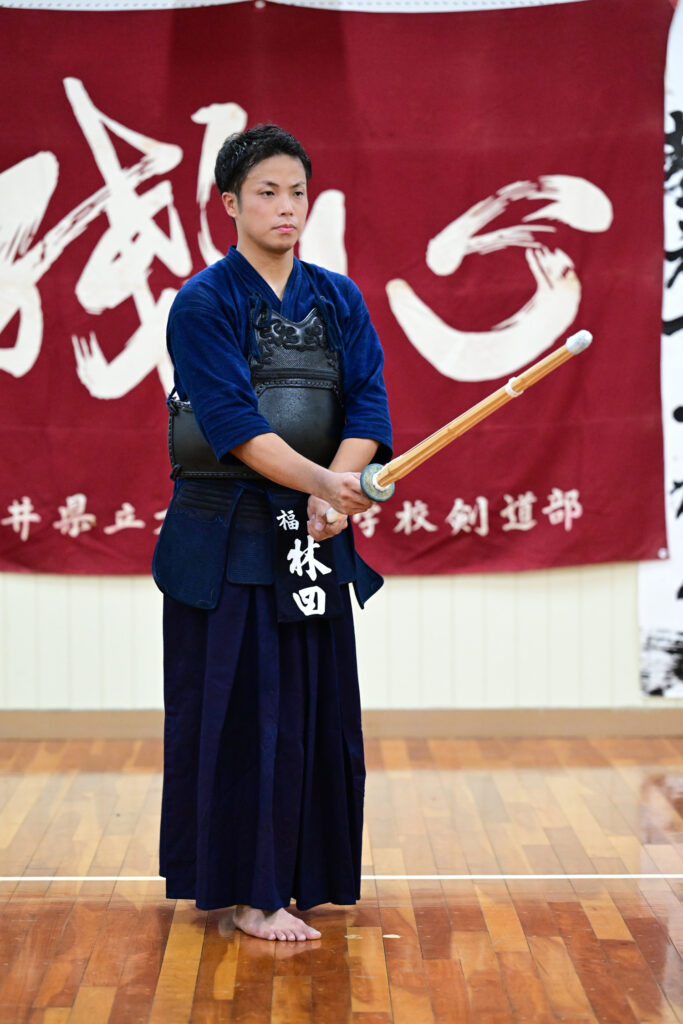
Hayashida states that relaxing his Kamae has enhanced the sharpness of his Men strikes. By eliminating unnecessary tension, he has also improved his defensive responses and reduced fatigue during matches.
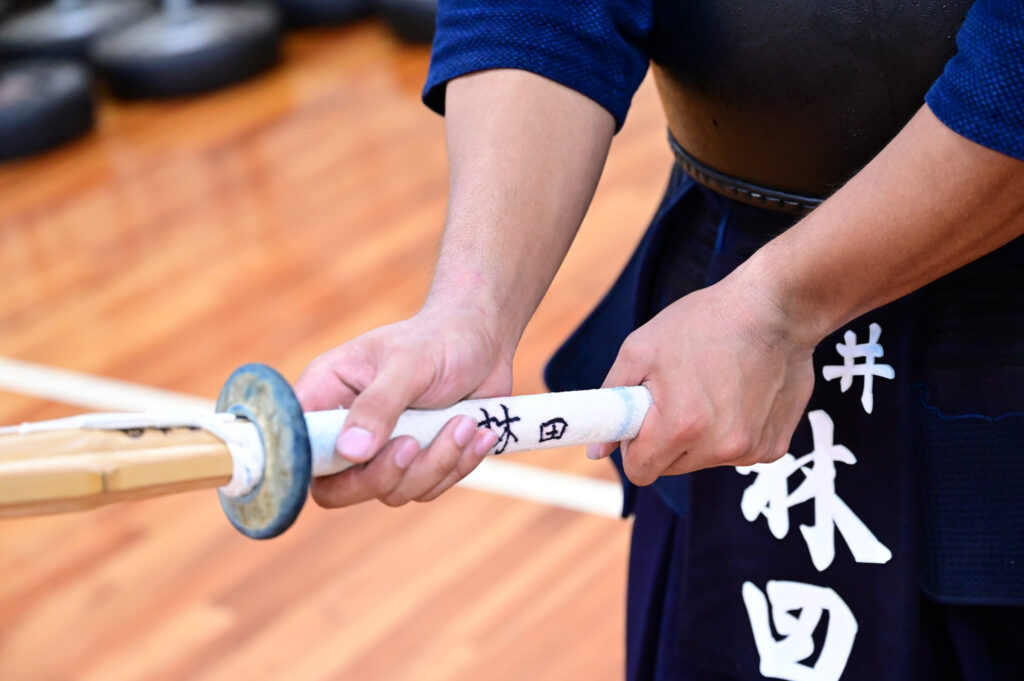
The foundation of relaxation lies in Hayashida’s grip with his right hand. He holds the Shinai lightly, with minimal pressure from his fingers, as if wrapping around the handle. This grip has eliminated upper body tension and allowed for a more solid Kamae.
Striking Motion
Another aspect I focus on to capture Debana opportunities is my striking motion. Debana techniques, which require instant execution, often result in lighter strikes. To counter this tendency and implement more effective Shinai control, I emphasize using my shoulders.
My commitment to relaxation naturally ties into utilizing the shoulders. When the upper body is tense, strikes tend to rely on the wrists, resulting in superficial hits. By engaging the shoulders, the power of the entire body is concentrated into the strike, transforming it from merely “hitting” the opponent to “cutting” through them.
An important detail in shoulder-driven strikes is the positioning of the left hand. It should remain steady and move forward with the same sensation as Tsuki, with the tip of the Shinai dropping at the final moment. If tension causes the left hand to waver, movements become slower, making it harder to seize Debana opportunities.
With these principles in mind, I focus my Seme on the Omote and Ura Men strikes, applying pressure to create openings in my opponent’s defense.
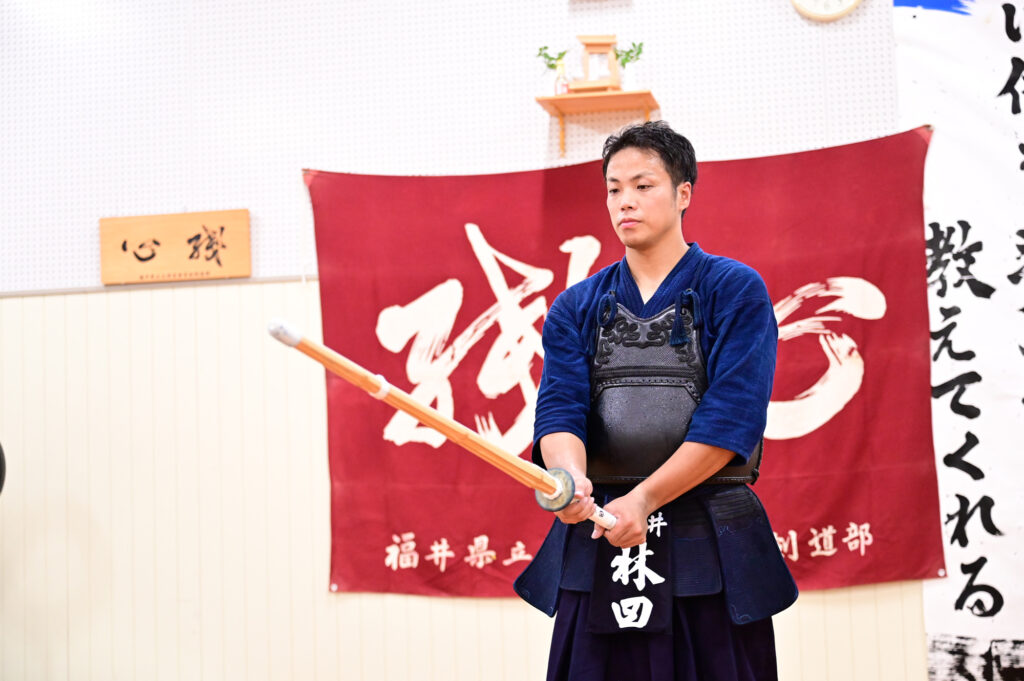
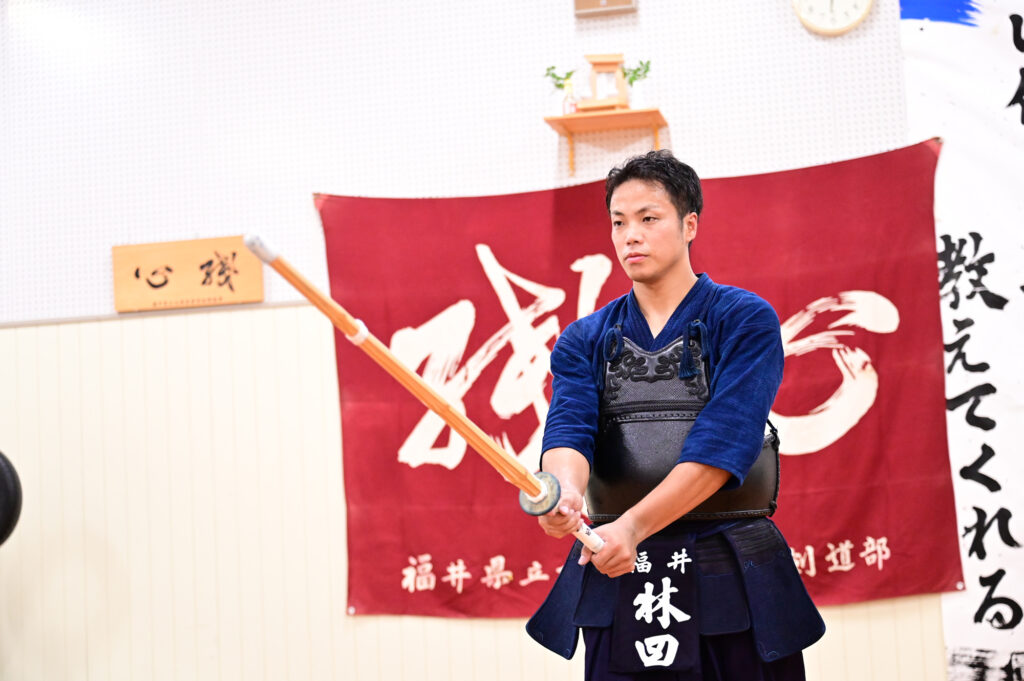
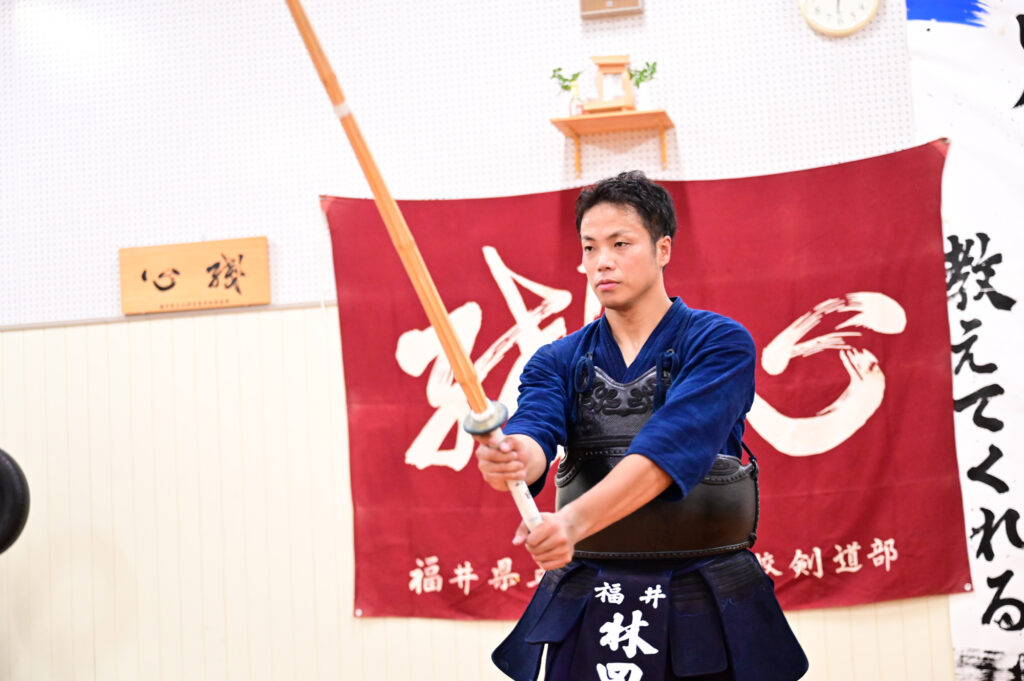
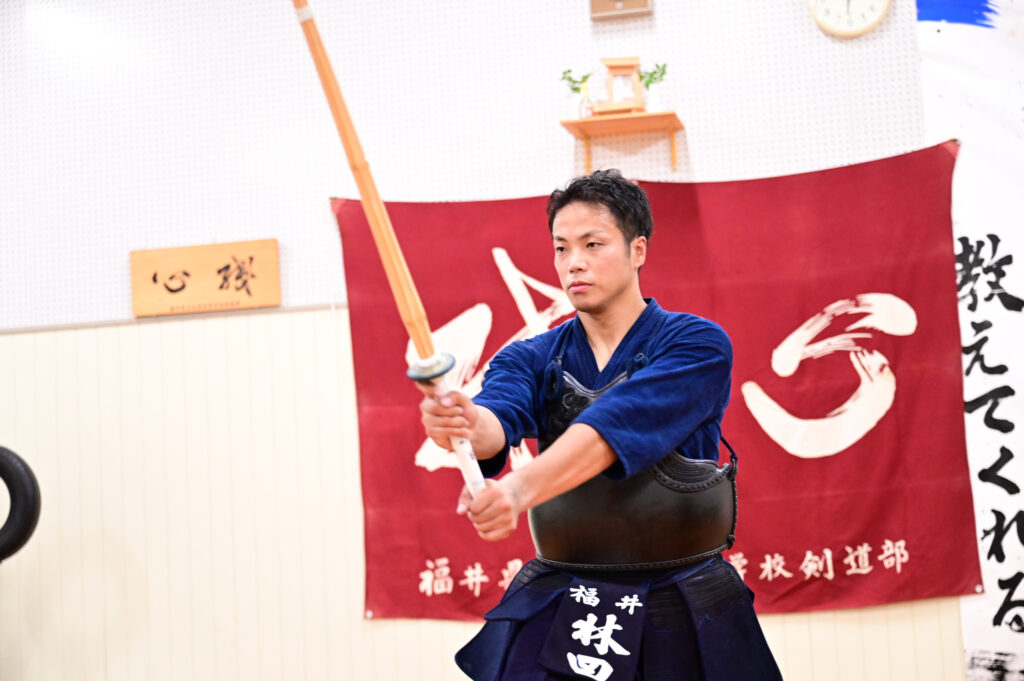
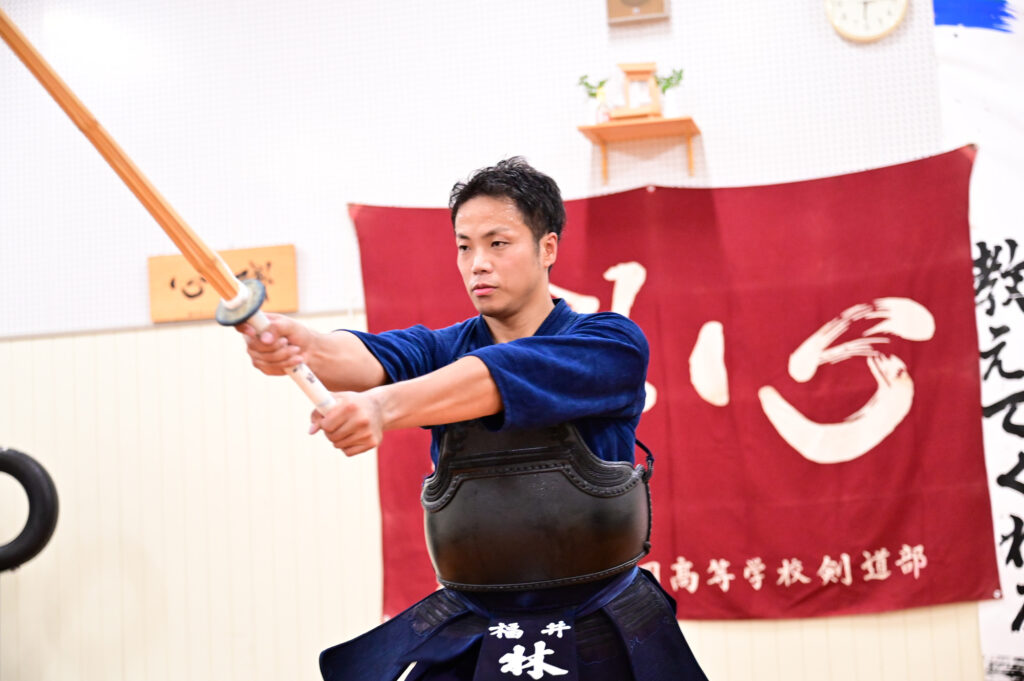
When transitioning into a strike, Hayshida focuses on using his shoulders. By adopting a relaxed Kamae, the striking motion naturally incorporates shoulder engagement.
Men Strikes from the Omote Side
The rest of this article is only available for Kendo Jidai International subscribers!
